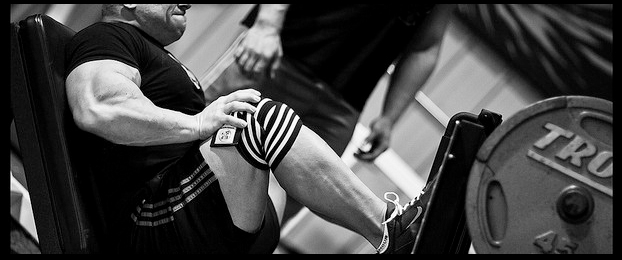
Last summer, I worked with a college running back who was contemplating quitting football because of chronic hamstring injuries. His injuries had started in high school and had continued on through his first two years of college. He actually had well-developed hamstrings and great hamstring flexibility, and he was exceptionally strong. And he should be. He had been working on hamstring strength and had been stretching religiously for three years. This is what he was told to do over and over again by his high school coach, college team physician, athletic trainer, and strength coach.
Muscle strains are not always the result of tight or weak muscles. Many times, the injured muscle is functioning just fine right up until the causative event. What we need to do first is look at the mechanisms of injury. During sprinting or while kicking, the hamstring lengthens across the hip as it flexes and across the knee as it extends. Eccentric hamstring strength plays a role at this point by decelerating the lower leg at maximum length.
In the most recent NSCA Strength and Conditioning Journal, an excellent article appeared on this exact topic (Brughelli and Cronin 2008). The authors examined the length tension curve of the hamstring and the location of an athlete’s peak tension. Injuries tend to happen during the descending portion of the curve and what they found was that reduction in injury coincided with an increase in the optimum length of the peak tension. In other words, athletes produce greater eccentric hamstring tension at longer muscle lengths. The authors presented several studies to back this up.
They also provided a variety of eccentric hamstring strengthening exercises. (Read the article for more detail.) My personal favorite is the stability ball bridge and curl. The hips must remain extended throughout the curl portion of the lift. Hip extension is a secondary function of the hamstring group, which brings me to my next point…


A second mechanism of injury occurs as the athlete’s lead foot makes contact and then propels the athlete forward again. Track athletes are often taught to “reach and pull” with the lead leg to increase stride. This is a bad idea. This goes back to the length tension curve again. The hamstrings are maximally lengthened and then have to perform a maximum contraction to pull the sprinter’s body over that leg. It is a concentric contraction at this point, but the hamstrings are passively insufficient. This means that they are lengthened too much to generate the appropriate force.
No special exercises are needed here. Just train or rehabilitate your athletes by teaching them to “push” rather than “pull.” This will allow the glutes and quads to come into play to a much greater extent, taking the load off of the hamstrings. The lead leg will now land appropriately under the athlete allowing for proper hip extension, a greater stride, and additional speed.
A third mechanism has to do with synergistic dominance. Many muscles are often responsible for a certain movement. In this case, we are referring to hip extension. Synergistic dominance involves one muscle overpowering the others. Hip extension is supposed to be the job of the glutes, but what often happens is that the hamstrings become the dominant muscle group. This is not at all what they were designed to do and leaves them greatly overworked. So the athlete with the strong hamstrings and chronic strains can actually blame his weak glutes.
Here are a couple simple tests to determine hamstring dominance over the glutes.
- Prone hip extension (also known as “testing the firing system”): Palpate the glutes and hamstrings and ask the athlete to perform a straight leg raise. The glutes should fire first. If not, the athlete is hamstring dominant. You may find that the athlete can’t even voluntarily fire the glutes without kicking in the hamstrings.
- Double leg bridge: Palpate the glutes and hamstrings again and ask the athlete to lift the hips. As before, the glutes should initiate and the hamstrings should only provide minimal assistance. We’ve probably all had someone cramp up in the hamstrings when attempting a bridge. That’s a problem. The athlete really should be able to contract the glutes and lift the hips with little to no hamstring involvement at all.
Now that we have established whether or not the hamstrings have dominance, how do we rewire the athlete? Here are a few things to try:
- Double leg bridge with foam roller: The roller goes under the thighs just above the knees. Have the athlete perform a glute set first and then lift the hips. It’s almost impossible to contract the hamstrings in this position. To see a demonstration of this movement, view the video.
- Double leg bridge: Have the athlete press through the heels with the toes up (this will actually increase the contribution of the quad but reciprocally inhibits the hamstrings). Have the athlete tighten the glutes and then lift the hips. Manually cue the athlete to keep the hamstrings turned off.
- Single leg bridge: Have the athlete press through the heel with the toes up. Have the athlete tighten the glutes and then lift again attempting to shut off the hamstrings.
I also have my athletes work in the prone position from time to time as well as attempt to contract the glutes first and then perform a hip extension. This can be done with the knees straight or bent. If the knees are bent, the therapist or trainer must support the lower leg. If the athlete really struggles with this, have the athlete press the leg into your hand to engage the quads and inhibit the hamstrings. Then have the athlete tighten the glutes.
References
Brughelli M, Cronin J (2008) Preventing Hamstring Injuries in Sport. NSCA Strength and Conditioning Journal 30:55–64.









